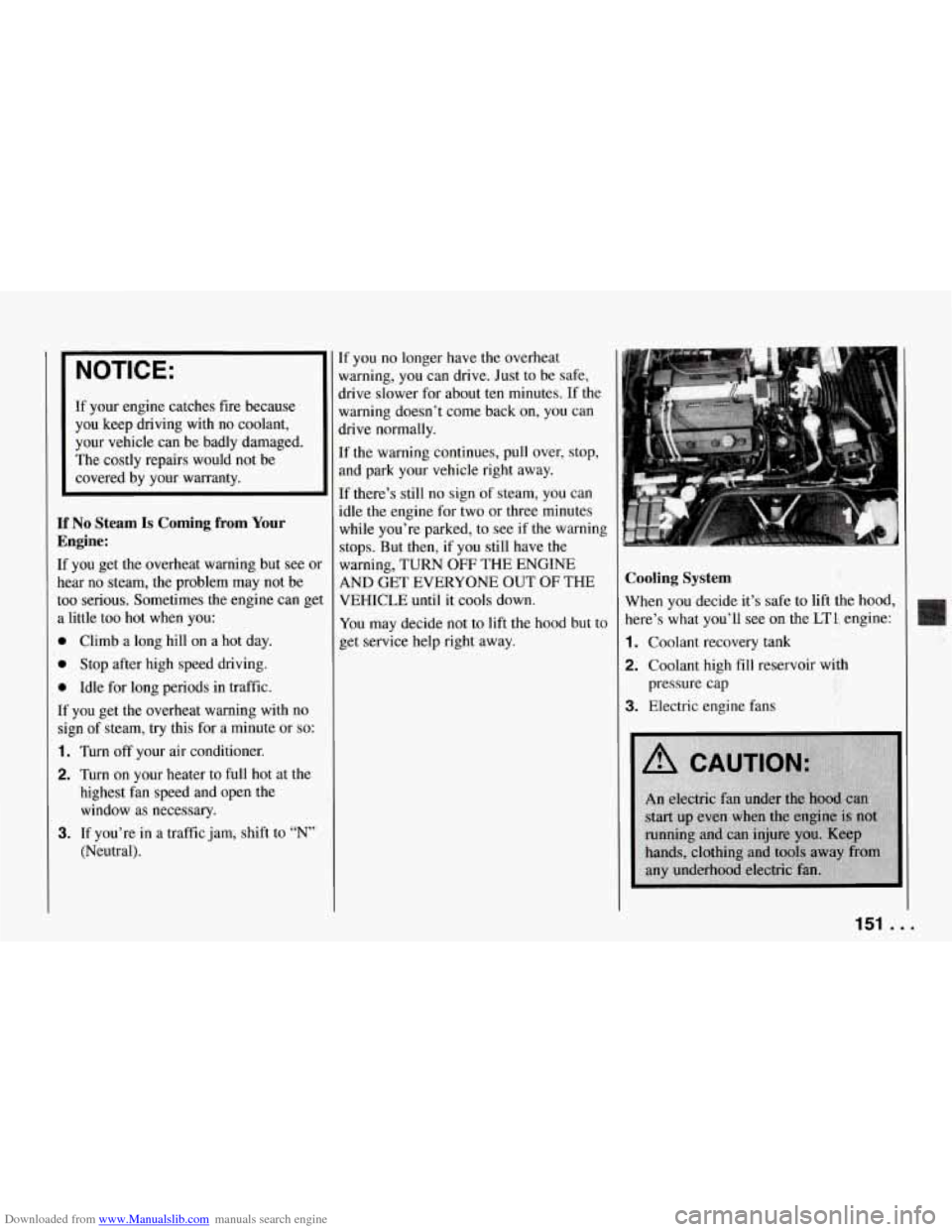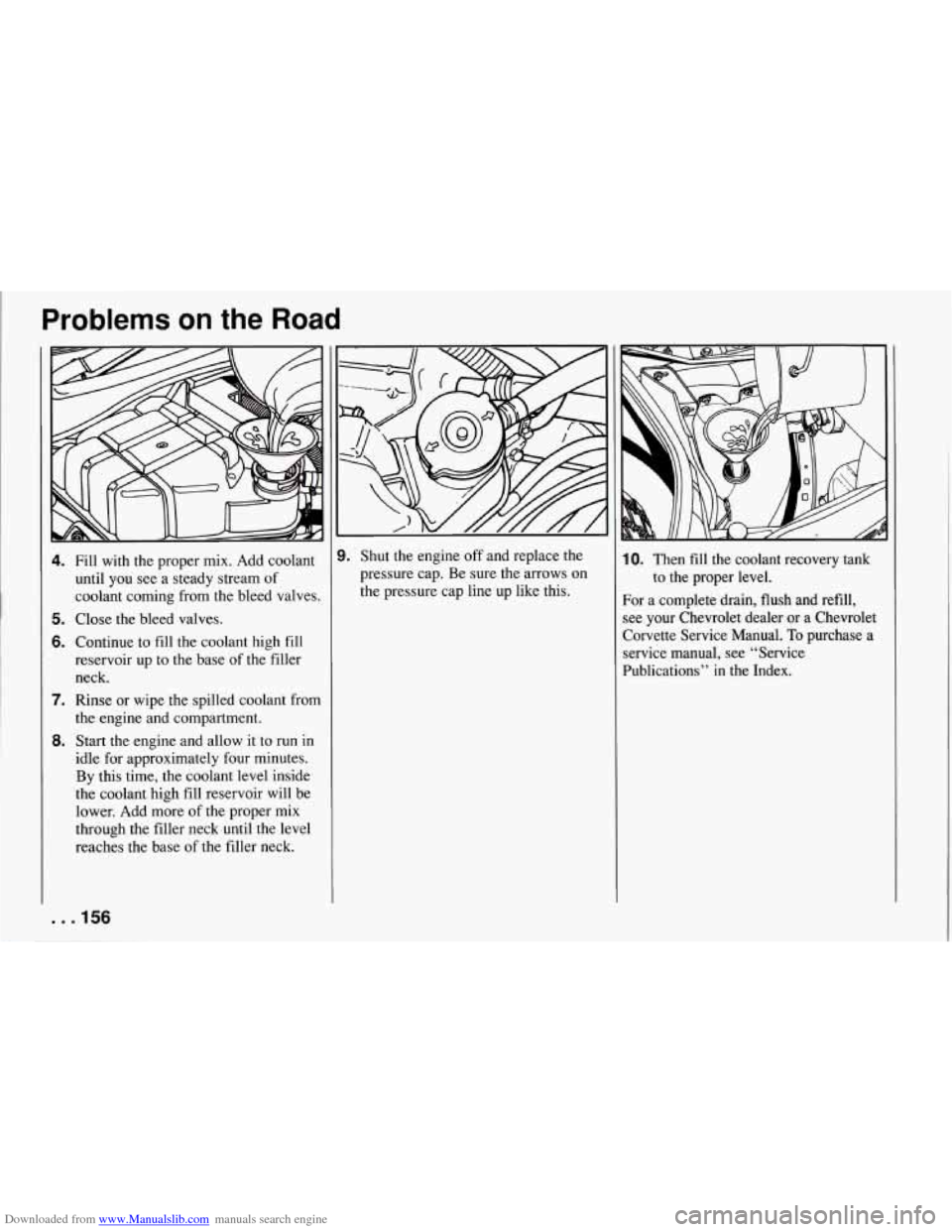Page 152 of 274

Downloaded from www.Manualslib.com manuals search engine NOTICE:
If your engine catches fire because
you keep driving with no coolant,
your vehicle can be badly damaged.
The costly repairs would not be covered by your warranty.
If No Steam Is Coming from Your
Engine:
If you get the overheat warning but see 01
hear no steam, the problem may not be
too serious. Sometimes the engine can ge
a little too hot when you:
0 Climb a long hill on a hot day.
0 Stop after high speed driving.
0 Idle for long periods in traffic.
If you get the overheat warning with no
sign of steam,
try this for a minute or so:
1. Turn off your air conditioner.
2. Turn on your heater to full hot at the
highest fan speed and open the
window as necessary.
(Neutral).
3. If you’re in a traffic jam, shift to “N’
[f you no longer have the overheat
warning, you can drive. Just to be safe,
hive slower for about ten minutes. If the
warning doesn’t come back on, you can
drive normally.
[f the warning continues, pull over, stop,
and park your vehicle right away.
[f there’s still no sign of steam, you can
idle the engine for two or three minutes
while you’re parked, to see if the warning
stops. But then, if you still have
the
warning, TURN OFF THE ENGINE
AND GET EVERYONE OUT
OF THE
VEHICLE until it cools down.
You may decide not to lift the hood but to
get service help right away.
Cooling System
When you decide it’s safe to lift the hood,
here’s what you’ll see on the LTl engine:
1. Coolant recovery tank
2. Coolant high fill reservoir with
3. Electric engine fans
pressure cap
151 ...
Page 153 of 274
Downloaded from www.Manualslib.com manuals search engine Problems on the Road
F
Cooling System
When you decide it’s safe to lift the hood,
here’s what you’ll see on the
LT5 engine:
1. Coolant recovery tank
2. Coolant high fill reservoir with
3. Electric engine fans
pressure cap
. . -152
If
the coolant inside the coolant recovery
tank is boiling, don’t do anything else
until it cools down.
When it is cool, remove the coolant
recovery tank cap and look at the dipstick.
The coolant level should be at or above
“COLD.” If it isn’t, you may have a leak
in the radiator hoses, heater hoses,
radiator, water pump or somewhere else
in the cooling system.
I NOTICE:
I
Engine damage from running your
engine without coolant isn’t covered
by your warranty.
If there seems to be no leak, check
to see
if the electric engine fans are running.
If the engine is overheating, both fans
should be running.
If they aren’t, your
vehicle needs service.
Page 154 of 274
Downloaded from www.Manualslib.com manuals search engine How to Add Coolant to the Coolant
Recovery Tank
If you haven’t found a problem yet, but
the coolant level isn’t at or above the
“COLD, mark, add a
50150 mixture of
clean water (preferably distilled) and a
proper antifreeze at the coolant recovery
tank. (See “Engine Coolant” in the Index
for more information about the proper
coolant
mix.)
NOTICE:
I
In cold weather, water can freeze and
crack
the engine, radiator, heater core
and other parts. Use the recom-
mended coolant.
When the coolant in the coolant recovery
tank is at or above the
“COLD” mark,
start your vehicle.
If the overheat warning continues, there’s
one more thing you can try. You can add
the proper coolant mix directly to the
coolant high fill reservoir, but be sure the
cooling system is cool before you do it.
153 ...
Page 155 of 274
Downloaded from www.Manualslib.com manuals search engine Problems on the Road
How to Add Coolant to the Coolant
High
Fill Reservoir - LT1 Only
NOTICE:
I
The LT1 engine (Code P) has a
specific coolant high fill reservoir
fill procedure. Failure to follow this
procedure could cause your engine to
overheat and be severely damaged.
1. You can remove the coolant high fill
reservoir pressure cap when the
cooling system, including the coolant
high fill reservoir pressure cap and
upper radiator hose,
is no longer hot. Turn the pressure cap slowly to
the
left until
it first stops. (Don't press
down while turning the pressure cap.)
If
you hear a hiss, wait for that to stop.
A hiss means there is still some
pressure left.
. . .I54
Page 157 of 274

Downloaded from www.Manualslib.com manuals search engine Problems on the Road
4.
5.
6.
7.
8.
Fill with the proper mix. Add coolant
until you see a steady stream of
coolant coming from the bleed valves.
Close the bleed valves.
Continue to fill the coolant high fill
reservoir up to the base of the filler
neck.
Rinse or wipe the spilled coolant from
the engine and compartment.
Start the engine and allow it to run in
idle for approximately four minutes.
By this time, the coolant level inside
the coolant high fill reservoir will be
lower. Add more of
the proper mix
through the filler neck until the level
reaches the base
of the filler neck.
9. Shut the engine off and replace the
pressure cap. Be sure the arrows on
the pressure cap line up like this. 10. Then fill the coolant recovery tank
For a complete drain, flush and refill,
see your Chevrolet dealer or a Chevrolet
Corvette Service Manual.
To purchase a
service manual, see “Service
Publications’’ in the Index. to
the proper level.
. . .156
Page 158 of 274
Downloaded from www.Manualslib.com manuals search engine How to Add Coolant to the Coolant
High Fill Reservoir
(5.7L LT5 (Code J)
Engine)
1. You can remove the coolant high fill
reservoir pressure cap when the
cooling system, including the coolant
high fill reservoir pressure cap
and
upper radiator hose, is no longer hot.
Turn the pressure cap slowly to the
left until it first stops. (Don’t press
down while turning the pressure cap.)
If you hear a hiss, wait for that to stop.
A hiss means there is still some
pressure left.
2. Then keep turning the pressure cap,
but now push down as you turn it.
Remove the pressure cap. 3. Fill the coolant high fill reservoir with
the proper mix, up to the base of the
filler neck.
157 ...
Page 159 of 274
Downloaded from www.Manualslib.com manuals search engine Problems on the Road
4. Then fill the coolant recovery tank to
the “HOT” mark
on the dipstick.
5. Put the cap back on the coolant
recovery tank, but leave
the coolant
high fill reservoir pressure cap
off.
6. Start the engine and let it run until
you can feel the upper radiator hose
getting hot. Watch out for the engine
fans.
7. By this time the coolant level inside
the coolant high fill reservoir filler
neck may be lower. If the level is
lower, add more of the proper
mix
through the filler neck until the level
reaches the base of the filler neck.
. . .158
Page 177 of 274
Downloaded from www.Manualslib.com manuals search engine Service and Appearance Care
When you open the hood, you'll see:
1. Hydraulic Clutch Fluid Reservoir (if
2. Brake Fluid Reservoir
equipped)
. . .I76
1
Before closing the hood, be sure all
the filler caps are on.
'*?-
5.7L LTI (Code P)
3. Battery
4. Electrical Engine Fan
5. Air Cleaner
6. Coolant Recovery Tank
7. Power Steering Fluid Reservoir
8. Engine Oil Fill Cap
9. Engine Oil Dipstick
10. Windshield Washer Fluid Reservoir
11. Coolant High Fill Reservoir
12. Automatic Transmission Dipstick
(if equipped)
I